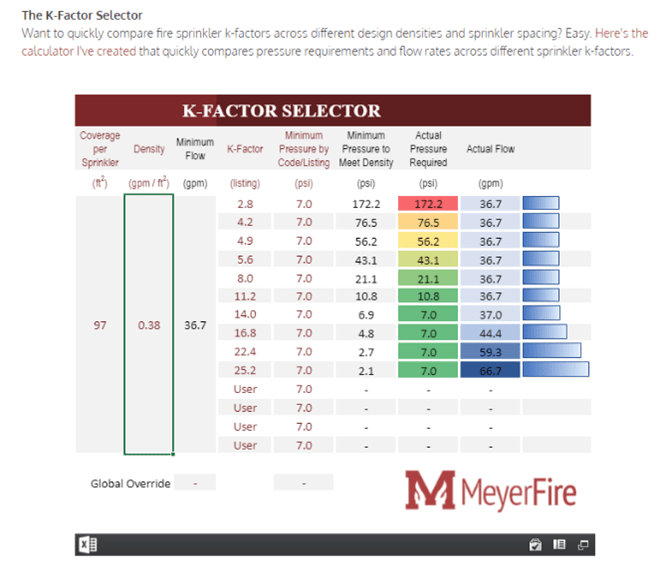Oh boy, I'm late to this party. I made an account for this.
My career is what you're doing right now; fire sprinkler design. I'm currently at NICET level II, and will be eligible for III this year.
Bluntly, you're in over your head here and you need to have someone else do this or prepare for weeks of reading NFPA 13 and probably use different software or break out some spreadsheets and graph paper.
You are not limited to 8 heads per branch, nor any size requirements except that 1 inch pipe is the minimum size except in rare edge cases, none of which you'll find in EHII. That is the old pipe schedule system that served for uncalculated systems, which are no longer allowed to be installed. If you see a sprinkler system following that sizing and it's 30+ years old, you may be looking at a schedule system.
The 7psi minimum is for any sprinkler, meaning if it's in a 24 ft^2 light hazard closet, required operating pressure is 7psi regardless of coverage area and density showing that 2.4gpm is required and therefore pressure will be almost negligible.
For such a case, flow is also adjusted accordingly, and the head would operate based on Q=K*sqrtP
Overall, hydraulic calculation is not going to be well served or accurate by your chosen method.
To start, the table with area/density requirements is not your only limitation. I haven't taken a thorough look but there are stringent requirements for how that area is to be determined, not just its size.
Secondly, there are two pressures a sprinkler system cares about: static and residual. That being pitot tube pressure at 0 flow and available pressure at flow demand condition.
(You can use normal pressure calculations based on the velocity pressure formula found in NFPA 13, but this is extremely rarely practiced.)
Additionally, calculations are near recursive processes due to how they are performed.
You will start your calcs backwards, at the end head of your remote area, using Hazen-Williams. It's not enough to say "x gpm per y sprinklers" and run.
I'll make the math easier for myself and call your end head 100ft^2 at .4gpm/ft^2. Its flow is 40gpm, and with 11.2K, pressure required is nearly 12.8psi while flowing. Calculate pressure loss through the pipe to the next flow device, size change, or C factor change, adding equivalent lengths.
Next head, add another 40gpm, calc a now 80gpm of flow to the next change, and so on.
13 heads is 520gpm at the main/branch line intersection of your end line, and if that pipe isn't huge I shudder to consider how much you're losing per foot. Your end head pressure plus the sum of all the friction/elevation losses up to this point is now your overall pressure demand at that 520gpm.
Calc flow demand through main back towards riser to next branch line.
Now, if the branch line is identical, you'd be fine to assume its calculated demand is 520gpm at the same pressure. However, your overall demand is slightly higher due to demand from the friction loss across the main, and NFPA requires you to balance the pressure demand at that intersection to within 0.5psi, so if there is a larger discrepancy, you must adjust the flows of the heads on that line until the pressure demand is within 0.5 psi of demand 1 (branch line 1 + cross main friction loss). Your new demand let's call an even 1100 because I'm not going to actually go through that process manually.
(The other variable you can control to inflate pressure demand at an intersection is pipe size downstream. You can try that but loss is drastically different on the smaller diameters at the flows you've got.)
Calc 1100gpm worth of friction loss down the main to the third branch line. Repeat the balancing procedure for branch line 3. Note that because your loss through the main is now 1100 you're losing more to friction loss from line 2 to 3 than 1 to 2, and balancing line 3 will have accordingly increased overflow.
Repeat until you reach either base of riser, or preferably a fire hydrant or other water supply connection where a flow test was performed. Add outside hose allowance here.
Bear in mind that elevation loss/gain is calculated from reference point to reference point, so while this isn't the case for your building, branch lines on a pitch with one side going up from the main and the other going down will induce massive overflow at intersections unless you adjust branch line sizes accordingly.
If this system is existing, my recommendation would be to attempt a calculation based on relocating the main to split the branch lines with 6/7 heads on each side, setting the main closer to the 7 head side than the 6 to reduce overflow. From there, if it didn't work you'd be looking at either increasing the main/riser size, gutting the branch lines to increase their sizes, or making a grid system probably. Either that or estimating if adding a fire pump and its corresponding code parsing is cheaper.
Last point: you can eliminate one fitting serving the sprinkler (is, the tee or reducer the head screws into) per head from equivalent length calculations. So if the head screws directly into the tee you can omit that tee, but that still won't do a whole lot for you.
Best of luck, although I assume that by now this problem has reached a conclusion.


